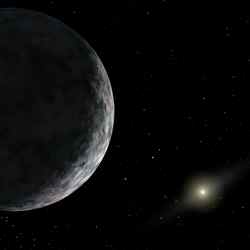
Artist’s concept of Xena the Sun, appearing from a distance. Image credit: NASA/JPL-Caltech. Click to enlarge
In the not-too-distant past, the planet Pluto was thought to be an odd bird in the outer reaches of the solar system because it has a moon, Charon, that was formed much like Earth’s own moon was formed. But Pluto is getting a lot of company these days. Of the four largest objects in the Kuiper belt, three have one or more moons.
“We’re now beginning to realize that Pluto is one of a small family of similar objects, nearly all of which have moons in orbit around them,” says Antonin Bouchez, a California Institute of Technology astronomer.
Bouchez discussed his work on the Kuiper belt at the winter meeting of the American Astronomical Society (AAS).
Bouchez says that the puzzle for planetary scientists is that, as a whole, the hundreds of objects now known to inhabit the Kuiper belt beyond the orbit of Neptune have only about an 11 percent chance of possessing their own satellites. But three of the four largest objects now known in the region have satellites, which means that different processes are at work for the large and small bodies.
Experts have been fairly confident for a decade or more that Pluto’s moon Charon was formed as the result of an impact, but that the planet seemed unique in this. According to computer models, Pluto was hit by an object roughly one-half its own size, vaporizing some of the planet’s material. A large piece, however, was cleaved off nearly intact, forming Pluto’s moon Charon.
Earth’s moon is thought to have been formed in a similar way, though our moon most likely formed out of a hot disk of material left in orbit after such a violent impact.
Just in the last year, astronomers have discovered two additional moons for Pluto, but the consensus is still that the huge Charon was formed by a glancing blow with another body, and that all three known satellites-as well as anything else not yet spotted from Earth-were built up from the debris.
As for the other Kuiper belt objects, experts at first thought that the bodies acquired their moons only occasionally by snagging them through gravitational capture. For the smaller bodies, the 11 percent figure would be about right.
But the bigger bodies are another story. The biggest of all – and still awaiting designation as the tenth planet – is currently nicknamed “Xena.” Discovered by Caltech’s Professor of Planetary Science Mike Brown and his associates, Chad Trujillo of the Gemini Observatory and David Rabinowitz of Yale University, Xena is 25 percent larger than Pluto and is known to have at least one moon.
The second-largest Kuiper belt object is Pluto, which has three moons and counting. The third-largest is nicknamed “Santa” because of the time of its discovery by the Mike Brown team, and is known to have two moons.
“Santa is an odd one,” says Bouchez. “You normally would expect moons to form in the same plane because they would have accreted from a disk of material in orbit around the main body.
“But Santa’s moons are 40 degrees apart. We can’t explain it yet.”
The fourth-largest Kuiper belt object is nicknamed “Easterbunny” – again, because of the time the Brown team discovered it – and is not yet known to have a moon. But in April, Bouchez and Brown will again be looking at Easterbunny with the adaptive-optics rig on one of the 10-meter Keck telescopes, and a moon might very well turn up.
Original Source: NASA Astrobiology
